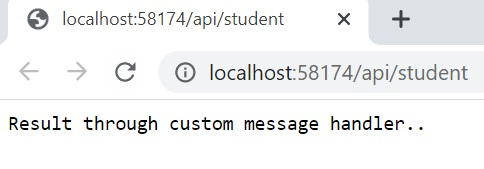
 Data Structure
Data Structure Networking
Networking RDBMS
RDBMS Operating System
Operating System Java
Java MS Excel
MS Excel iOS
iOS HTML
HTML CSS
CSS Android
Android Python
Python C Programming
C Programming C++
C++ C#
C# MongoDB
MongoDB MySQL
MySQL Javascript
Javascript PHP
PHP
- Selected Reading
- UPSC IAS Exams Notes
- Developer's Best Practices
- Questions and Answers
- Effective Resume Writing
- HR Interview Questions
- Computer Glossary
- Who is Who
How to add custom message handlers to the pipeline in Asp.Net webAPI C#?
To create a custom Server-Side HTTP Message Handler in ASP.NET Web API, we need to create a class that must be derived from the System.Net.Http.DelegatingHandler.
Step 1 −
Create a controller and its corresponding action methods.
Example
using DemoWebApplication.Models;
using System.Collections.Generic;
using System.Linq;
using System.Web.Http;
namespace DemoWebApplication.Controllers{
public class StudentController : ApiController{
List<Student> students = new List<Student>{
new Student{
Id = 1,
Name = "Mark"
},
new Student{
Id = 2,
Name = "John"
}
};
public IEnumerable<Student> Get(){
return students;
}
public Student Get(int id){
var studentForId = students.FirstOrDefault(x => x.Id == id);
return studentForId;
}
}
}
Step 2 −
Create our own CutomerMessageHandler class.
Example
using System.Net;
using System.Net.Http;
using System.Threading;
using System.Threading.Tasks;
namespace DemoWebApplication{
public class CustomMessageHandler : DelegatingHandler{
protected async override Task<HttpResponseMessage>
SendAsync(HttpRequestMessage request, CancellationToken cancellationToken){
var response = new HttpResponseMessage(HttpStatusCode.OK){
Content = new StringContent("Result through custom message handler..")
};
var taskCompletionSource = new
TaskCompletionSource<HttpResponseMessage>();
taskCompletionSource.SetResult(response);
return await taskCompletionSource.Task;
}
}
}
We have declared the CustomMessageHandler class derived from DelegatingHandler and within that we have overriden the SendAsync() function.
When a HTTP request arrives CustomMessageHandler will execute and it will return one HTTP message on its own, without processing the HTTP request further. So ultimately we are preventing each and every HTTP request from reach its higher level.
Step 3 −
Now register the CustomMessageHandler in Global.asax class.
public class WebApiApplication : System.Web.HttpApplication{
protected void Application_Start(){
GlobalConfiguration.Configure(WebApiConfig.Register);
GlobalConfiguration.Configuration.MessageHandlers.Add(new
CustomMessageHandler());
}
}
Step 4 −
Run the application and provide the Url.

From the above output we could see the message that we have set in our CustomMessageHandler class. So the HTTP message is not reaching the Get() action and before that it is returning to our CustomMessageHandler class.

